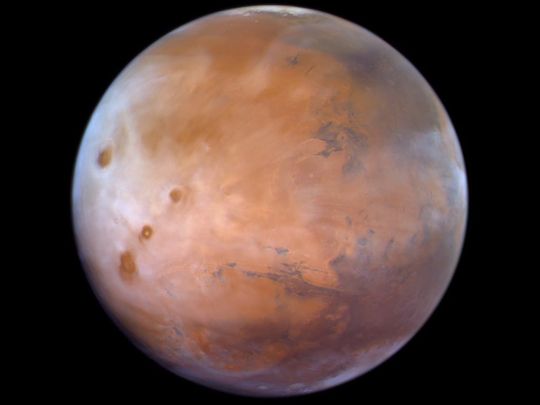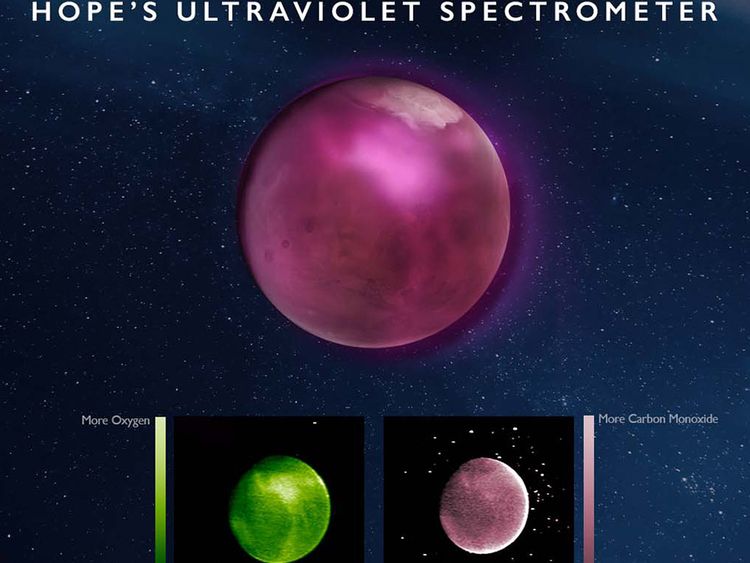
Dubai: The Emirates Mars Mission’s unmanned Hope Probe spacecraft in the Martian orbit has discovered higher than expected amounts of oxygen on the planet.
The announcement came on Saturday in a tweet also showing spring season in the northern part of Mars, posted by His Highness Sheikh Mohammed bin Rashid Al Maktoum, Vice President and Prime Minister of the UAE and Ruler of Dubai.
Hope Probe is studying Mars’ atmosphere is unprecedented detail using a variety of sensors and cameras.
The UAE on Saturday began sharing the scientific data it obtained on Mars so far with the rest of the global research centres, Sheikh Mohammed said.
“These observations, and our previously announced observations of Mars’ discrete aurora, are part of the first data release that went out in Oct 1st . From now onwards, we will be releasing new data sets every three months without embargo and free for use to the community,” the Mars mission also said in a series of tweets on Saturday.
Speaking about the discovery of greater than expected concentrations of oxygen in the Martian atmosphere, the tweets added: “The EMM team had expected to observe a relatively uniform emission from oxygen at 130.4 nm across the planet and yet here we are, faced with unpredicted variations of 50% or more in the brightness [in the images showng the oxygen concentrations].”
The findings were spotted using the probe’s ultraviolet spectrometer.
New insights
Emirates Mars Mission Science Lead Hessa Al Matroushi said: “These observations contain features that were completely unexpected and we believe will have far-reaching consequences for our existing models of the Martian atmosphere and our understanding of its behaviour. We simply hadn’t anticipated structures of this magnitude and complexity."
The observations confound scientist’s preconceptions of the distribution of ultraviolet light emitted from the upper atmosphere of Mars, showing vast structures at a range of wavelengths suggesting a higher than expected variation in the density of atomic oxygen and pointing to unusual levels of atmospheric turbulence. Taken at a time when Mars was near the aphelion of its orbit (furthest from the Sun) and when solar activity was low, the images are at their most striking and remarkable in emissions from oxygen at the 130.4 nm wavelength.
“It was so unexpected that we initially thought the structures might be artefacts in the image, caused by contaminating light from longer wavelengths that the instrument is designed to reject,” said EMM Deputy Science Lead Justin Deighan.
“We had expected to observe a relatively uniform emission from oxygen at 130.4 nm across the planet and yet here we are, faced with unpredicted variations of 50 per cent or more in the brightness. The science team is currently refining their models to come up with a robust interpretation of these findings. It’s very exciting to be challenged this way; this is exactly the type of science the mission was designed to pursue.”
The Emirates Mars Mission is studying the relationship between the upper layer and lower regions of the Martian atmosphere, giving the international science community full access to a holistic view of the Martian atmosphere at different times of the day, through different seasons.
One sweep every 55 hours
The Mission’s Hope Probe is following its planned 20,000 to 43,000km elliptical science orbit, with an inclination to Mars of 25 degrees, giving it a unique ability to complete one orbit of the planet every 55 hours and capture a full planetary data sample every nine days throughout its one Martian year (two Earth years) mission to map Mar’s atmospheric dynamics.
About the mission
EMM and the Hope probe are the culmination of a knowledge transfer and development effort started in 2006, which has seen Emirati engineers working with partners around the world to develop the UAE’s spacecraft design, engineering and manufacturing capabilities.
Hope is a fully autonomous spacecraft, carrying three instruments to measure Mars’ atmosphere. Weighing some 1,350kg, and approximately the size of a small SUV, the spacecraft was designed and developed by MBRSC engineers working with academic partners, including LASP at the University of Colorado, Boulder; Arizona State University and the University of California, Berkeley.
The Hope Probe’s historic journey to the Red Planet coincides with a year of celebrations to mark the UAE’s Golden Jubilee.







